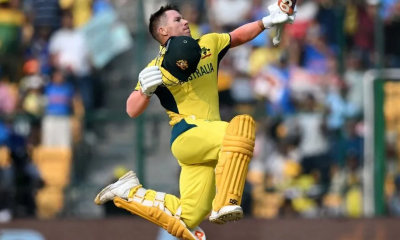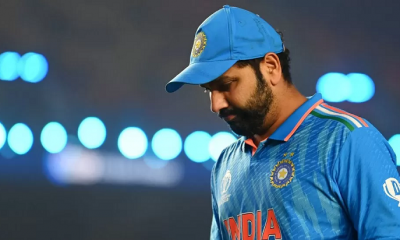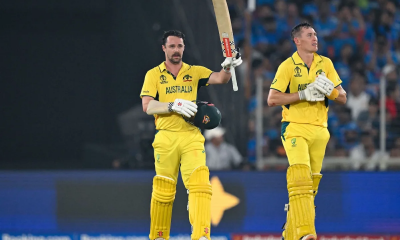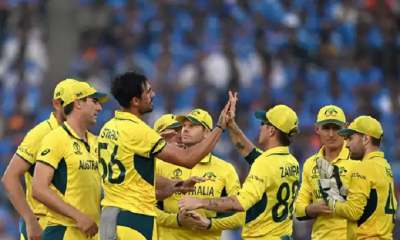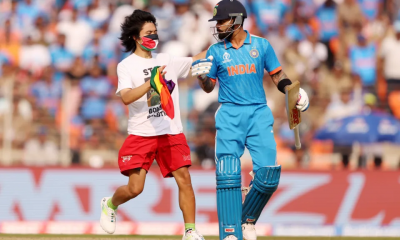Sports
Head knocks the wind out of India as Australia clinch sixth World Cup
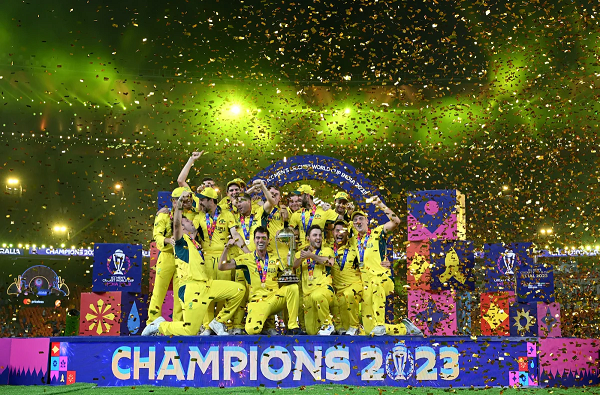
After 10 consecutive wins to reach the final, India were outplayed by Australia on a slow Ahmedabad pitch as the visitors clinched an eye-popping sixth men’s World Cup title. If Australia’s bowlers put the choke-hold to restrict India to 240, it was Travis Head who delivered the final slam with his rollicking 120-ball 137 as they cruised to a six-wicket win.
Head, playing decisive roles in the semifinal and final of a World Cup, ensured he placed his name in history and joined an elite list of Mohinder Amarnath, Aravinda de Silva and Shane Warne to win Player of the Match awards in the knockout games.
The chase was not without stutters early on, as Australia slipped to 47/3 albeit with a healthy run-rate. Mohammed Shami, tasked with the new ball for the first time in this World Cup, struck with his second ball to have David Warner caught at slip. Jasprit Bumrah, after conceding 15 in his first over, bounced back to have Mitchell Marsh caught behind and outfoxed Steven Smith with a slower ball. Smith chose not to review with replays later confirming that he was struck outside off, and it betrayed signs of nerves in the chase.
However, Head along with a disciplined Marnus Labuschagne slowly and steadily reversed the pressure with a 192-run stand. With the spinners not getting much purchase on a slow surface, the duo stuck to their plans of rebuilding with a mixture of defence and attack. India’s second line of attack fell apart as Head first slog-swept Kuldeep Yadav for a six and Jadeja was consistently milked. It meant that the final became the only game in this World Cup where India’s spinners went wicketless, with the slowness off the surface largely negating their threat whatsoever.
Nevertheless, the duo played the conditions perfectly hitting boundaries early in the return spells to ensure that India never had an opening thereafter. They put on a massive partnership for the fourth wicket, to take the game away clinically from India. Head fell eventually with Australia needing just 2 more which was duly completed by Glenn Maxwell, to finish off the job started by their captain with the ball.
Earlier in the day, a clinical display of bowling to the conditions had enabled Australia to restrict India to a middling total of 240 after putting them in to bat.
In front of a capacity crowd over 100000, Pat Cummins decided to take a chance and bowl first on the dry pitch despite India’s imperious batting record through the tournament. His judgement call threatened to be proven wrong as India, led by Rohit Sharma once again, got the momentum in the powerplay.
Sharma set the tone with a string of boundaries hitting Josh Hazlewood off his lengths even as Shubman Gill fell miscuing to mid on. But Virat Kohli got going just like Sharma, hitting Mitchell Starc for three consecutive boundaries to keep India’s run-rate up.
So far it had played to India’s template with Rohit racing towards a quickfire fifty. But Australia kept them on their toes with the introduction of spin which paid dividends. Sharma tried to hit Maxwell out but ended up miscuing one high up and Travis Head completed a superb catch running back and across from cover-point. An already silenced crowd was stunned further when Shreyas Iyer fell nicking behind to a cutter from Cummins.
Losing two wickets in the space of four balls forced India into a position of consolidation, which was done resolutely by the duo of Kohli and KL Rahul. While they remained steadfast, it was also a period where Australia were equally standout with the ball, allowing no freebies whatsoever. The duo went through a period of 97 balls without a boundary with even the likes of Mitchell Marsh keeping the lines tight.
Leading the way with the bowling plans for the pacers was Cummins (10-0-34-2 without conceding a boundary) who had set the tone with his off-pace cutters. But India had their hopes up as Kohli brought up his 9th fifty of the tournament and 5th consecutive one. Those hopes were dashed though by Cummins’ ploy, as another banged-in cutter saw Kohli chopping on after 54. The weight of the 765 runs that Kohli had amassed through the tournament mattered little at this point as India were pushed into another corner.
They responded by changing up the batting order with Ravindra Jadeja getting a promotion. But even this ploy did not mess up Australia’s lines as the boundaries simply did not come. Rahul, who held up one end, also brought up a fifty but there was no big finish to cap it off this time. Australia now found reverse swing as well which added to the challenge. Hazlewood had Jadeja nicking behind from round the wicket while Starc mirrored that at the other angle to prise out the defiant Rahul.
Suryakumar Yadav’s attempts to shepherd the tail as well as give India a boost did not come off as he gloved a slow bouncer from Hazlewood, effectively ending any chance of a late surge as India were eventually bowled out for 240 – a total that proved too little on the back of Head’s calculated assault.
Brief scores
India 240 in 50 overs (Rohit Sharma 47, Virat Kohli 54, K L Rahul 66; Mitchell Starc 3-55, Josh Hazelwood 2-60, Pat Cummins 2-34) lost to Australia 241/4 in 43 overs (Travis Head 137, Marnus Labuschagne 58*; Jasprit Bumrah 2-43 ) by six wickets
(Cricbuzz)
Sports
England face Australia in the battle of champions
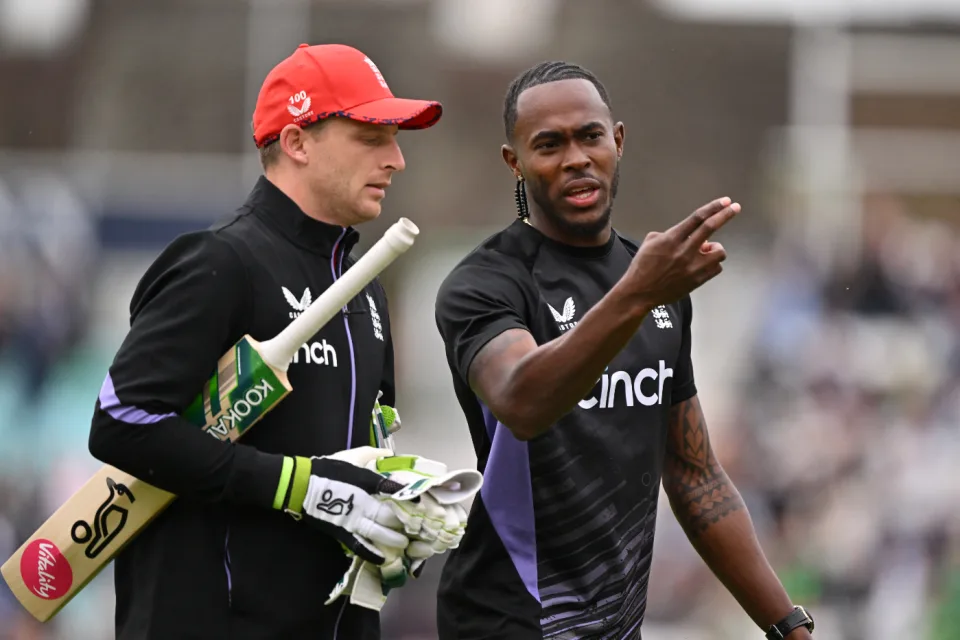
The first truly heavyweight clash of this expanded T20 World Cup format comes freighted with both history and subplots. A rematch of the 2010 World T20 final at Kensington Oval, the match pits Jos Buttler’s defending champions – who are aiming to become the first team to retain the trophy – against the Australian winning machine, victors at the 2021 edition and current world title-holders in Test and ODI cricket. And that’s before you throw in the Ashes for afters.
Already there is added pressure on England, after the rain in Bridgetown led to a share of the points in their opener against Scotland (and that having conceded 90 runs from 10 overs without taking a wicket in a tepid bowling display). Lose to their oldest rivals and it will leave their Super 8 prospects open to being waylaid by the perils of net run-rate calculations, or worse.
The Scotland match was the third abandonment in five suffered by England, after a rain-affected home series against Pakistan, which has clearly hampered their readiness for this campaign after almost six months without playing T20 together. It does not take much for a side to click in this format – and England looked in decent shape when they did get on the field against Pakistan – but Buttler will be anxious for things to go their way on Saturday, if only to avoid further questions referencing the team’s disastrous ODI World Cup defence last year.
Australia, under the laidback leadership of Mitchell Marsh would love nothing more than to add to the English sense of jeopardy – having helped bundle them out of the tournament in India on the way to taking the crown. Their head to head record is less impressive in T20 however, with England having won six of the last seven completed encounters, as well as that 2010 final.
Despite a wobble with the bat, Australia avoided mishap against Oman earlier in the week, the experience of David Warner and Marcus Stoinis shining through in difficult batting conditions. Surfaces in the Caribbean – not to mention those games staged in the USA – have already had teams scratching their heads; rather than the “slug-fest” England had prepared for, following a high-scoring tour of the Caribbean in December, it looks as if boxing smart may be the way to go.
Speaking of Warner, this could be the last time he faces up against England in national colours – and another match-winning contribution would likely reduce the chances of them meeting again in the knockouts. On the other side of the card is Jofra Archer, fresh from an emotional maiden outing at Kensington Oval and ready to take on Australia for the first time in any format since 2020. Can Mark Wood fire up England’s campaign, as he did during last summer’s Ashes? Will Pat Cummins be back to harass the old enemy once again? Seconds out, it’s almost time to rumble.
Cummins is set to return after being rested for the Oman game, which saw Mitchell Starc leave the field with cramp. Starc is understood to be fine and could keep his place – which would likely see Nathan Ellis miss out. Marsh is still not fit to bowl, with Australia likely to continue with the allrounder combination of Stoinis and Maxwell to give them cover.
Australia (probable XI): David Warner, Travis Head, Mitchell Marsh (capt), Glenn Maxwell, Marcus Stoinis, Josh Inglis (wk), Tim David, Pat Cummins, Nathan Ellis/Mitchell Starc, Adam Zampa, Josh Hazlewood
The one change England may consider is Reece Topley coming in for Wood, with the expectation that there will be some rotation among the seamers through the course of the tournament.
England (probable XI): Phil Salt, Jos Buttler (capt & wk), Will Jacks, Jonny Bairstow, Harry Brook, Liam Livingstone, Moeen Ali, Chris Jordan, Jofra Archer, Adil Rashid, Reece Topley/Mark Wood
[Cricinfo]
Sports
South Africa up against their bogey team in batter-unfriendly New York
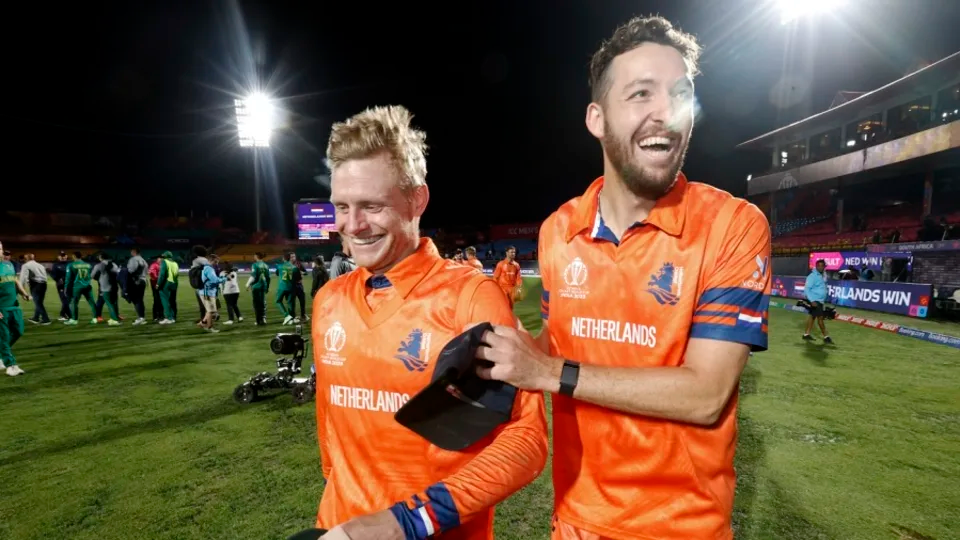
Once is coincidence, twice is a clue, and three times is proof.
To paraphrase Agatha Christie, that is the narrative around South Africa’s meeting with Netherlands at this T20 World Cup.
The Dutch beat South Africa at the 2022 tournament and ended their semi-final hopes in a match where South Africa appeared to be sleep walking, and then beat them again at the 2023 ODI World Cup, where they exposed South Africa’s vulnerability in the chase. If they to do the treble, not only will Netherlands take the lead in Group D, but they will offer conclusive evidence of the threat they pose to Full Members, especially South Africa.
Of course, it will take some doing after South Africa’s opening performance against Sri Lanka, where they reduced their opposition to their lowest T20I total and chased it down in fairly straightforward fashion thanks to the most stable middle-order of their white-ball era. In Aiden Markram, Tristan Stubbs, Heinrich Klaasen and David Miller, South Africa have bankers and big-hitters and, for this match, they also have the advantage of experience. They’ve already played at Eisenhower Park, and have first-hand knowledge that run-scoring doesn’t come easily;Klassen said they are prepared to use their “cricket brains” and play “smarter cricket”.
But the conditions could be good news for Netherlands, who are not naturally a line-up of big hitters and build their innings on a foundation of turning ones into twos. In other words, they tend to take a slightly more conservative approach to batting, which may work well here, but they’ll be wary of the uneven bounce of the surface and will have to come up with plans to counterattack especially against South Africa’s seamers. Their own bowlers were exemplary in Dallas and will look to build on that performance against a line-up that will likely be more proactive than Nepal’s, but who they have managed to keep quiet not once, but twice in the past. Third time’s the charm, they say.
Anrich Nortje’s stunning return to form against Sri Lanka means South Africa may not have to tinker with the bowling combination, and Gerald Coetzee and Tabraiz Shamsi may have to wait their turns to get a game. The batting line-up should be unchanged, with no space for Ryan Rickelton yet.
South Africa: Quinton de Kock (wk), Reeza Hendricks, Aiden Markam, Tristan Stubbs, Heinrich Klaasen (wk), David Miller, Marco Jansen, Keshav Maharaj, Kagiso Rabada, Ottneil Baartman, Anrich Nortje
Conditions in New York may tempt Netherlands to include an extra seamer and they have Kyle Klein in their squad. But it could come at the expense of a shortened batting line-up and they may not want to risk that.
Netherlands: Michael Levitt, Max O’Dowd, Vikramjit Singh, Sybrand Engelbrecht, Scott Edwards (capt, wk), Bas de Leede, Teja Nidamanuru, Logan van Beek, Tim Pringle, Paul van Meekeren, Vivian Kingma
[Cricinfo]
Latest News
Mustafizur, Rishad, Hridoy dazzle in Bangladesh’s tight two-wicket win over Sri Lanka
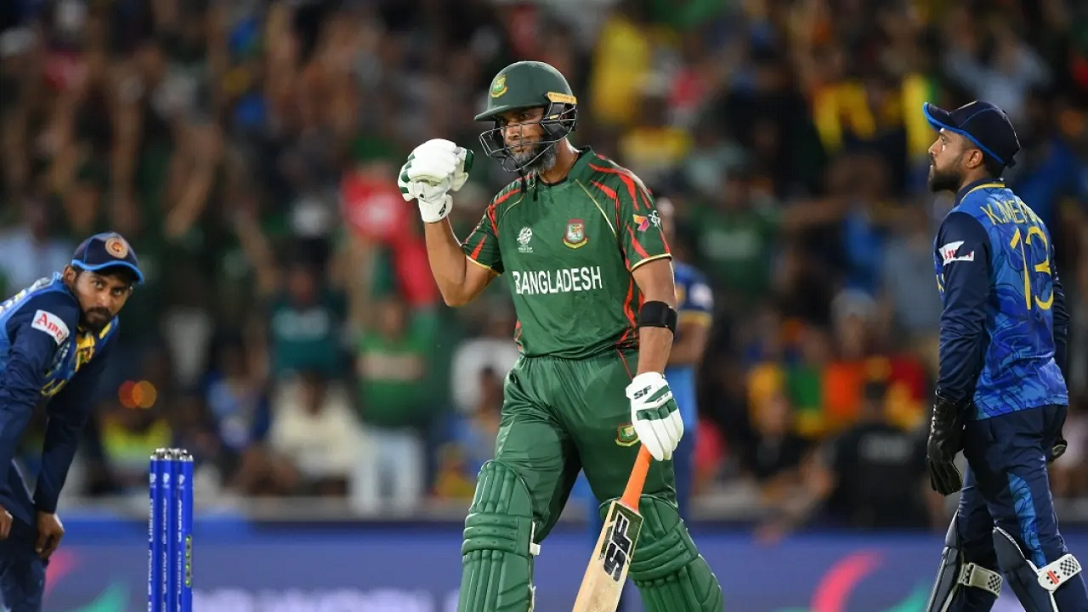
Nuwan Thushara’s last over brought Sri Lanka screaming back into the match,as he first bowled Rishad Hossain, and then nailed Taskin Ahmed in front of the stumps with a pinpoint swinging yorker. This left Bangladesh eight wickets down, with 12 runs still to get.
However, the experienced Mahmudullah was at the crease for Bangladesh, and despite some further nervy moments, pushed Bangladesh across the line off the last ball of the 19th over.
But this was a match chiefly decided by Bangladesh’s own outstanding bowling. Mustafizur Rahman was the best among them, using shorter lengths and his cutters efficiently, to claim figures of 3 for 17. Rishad Hossain’s three-for through the middle overs also kept Sri Lanka quiet.
Mustafizur was instrumental in Sri Lanka’s downward spiral through the middle overs, which culminated in a crash-and-burn end. Ultimately, their inability to find boundaries, or even rotate strike against good Bangladesh bowling resulted in their downfall. A score of 125 for 9 always seemed poor on a decent pitch, even if their bowlers made a match of it in the end.
Brief scores:
Bangladesh 125 for 8 in 19 overs (Towhid Hridoy 40, Litton Das 36; Dhanajaya de Silva 1-11, Nuwan Thushara 4-18, Wanidu Hasaranga 2-32, Matheesha Pathirana 1-27) beat Sri Lanka124 for 9 in 20 overs (Pathum Nissanka 47, Dhananjaya de Silva 21; Tanzim Hasan Sakib 1-24, Taskin Ahmed 2-25, Mustafizur Rahman 3-17, Rishad Hossain 3-22) by two wickets
[Cricinfo]


